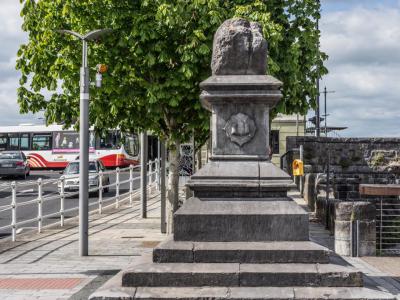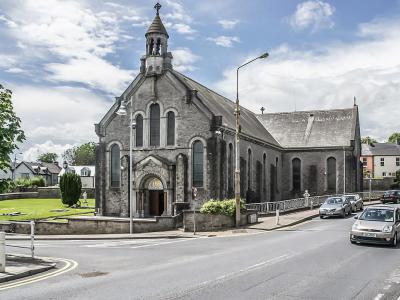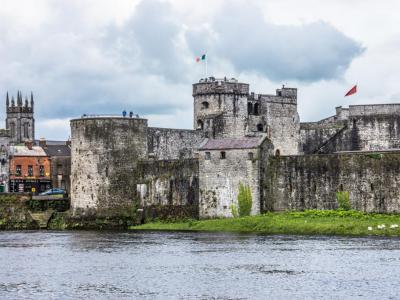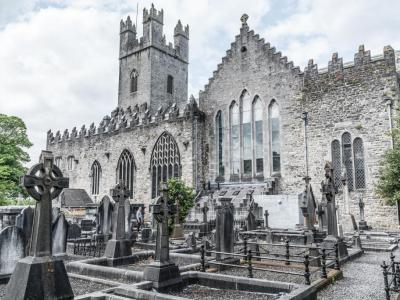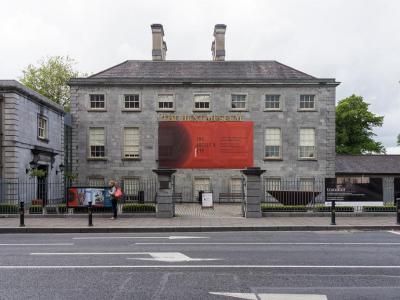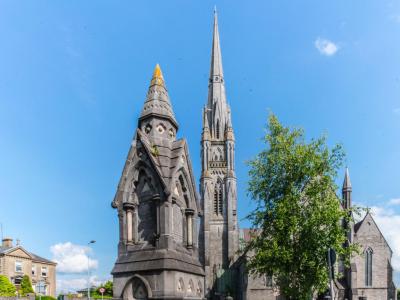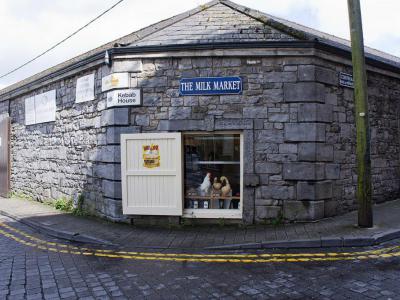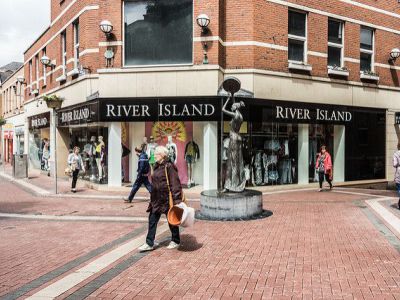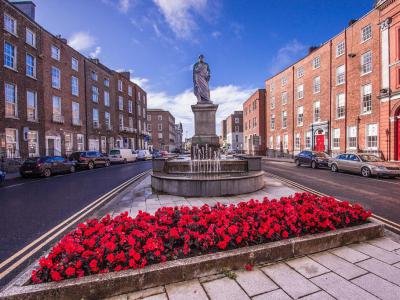Limerick Introduction Walking Tour (Self Guided), Limerick
Claudius Ptolemy, the great geographer of the ancient world, drew a map of Ireland in 150 AD. Indicated on the map was a place now called King's Island. It is said generous King Cormac ruled here in the 4th century. Here is where St Patrick baptized King Carthann the Fair in 434. Here is the ancient heart of Limerick.
St Munchin had been the first bishop of Limerick in 652. In 812, Vikings sailed up the Shannon and burned his monastery. The Normans brought stability in the 12th century. King John's Castle was built on King's Island, "joined at the hip" to historic St Mary's Cathedral.
In the 16th and 17th centuries, Limerick was celebrated for its "lofty buildings of Marble." The 1691 Treaty of Limerick ended the wars between the Jacobites and the supporters of William and Mary. The parties signed on the Treaty Stone, which stands on a plinth at one end of the Thomond Bridge in Limerick.
The compact Old City is easy to explore on foot. Start at the Treaty Stone, on its pedestal by the Shannon. Across the river is tourist-friendly King John's Castle. The Georgian Old Custom House in Newtown Pery houses ancient artifacts of the Hunt museum.
The famous "Big Top" Milk Market provides foods, delicacies, and music events. The Lime Tree Theatre and the Ballable Arts Theatre host works of local playwrights. Riverfest is held annually. Film festivals, comedy clubs, and nightclubs keep things lively. The Limerick International Band Championship hosts bands from Ireland and the world.
The connection of the city to the Limerick poem form is unclear. Earlier forms of verse had a refrain: "Will you or won't you come up to Limerick?" Now there's an invitation. There's a bit of Irish in everyone. Find your bit in Limerick.
St Munchin had been the first bishop of Limerick in 652. In 812, Vikings sailed up the Shannon and burned his monastery. The Normans brought stability in the 12th century. King John's Castle was built on King's Island, "joined at the hip" to historic St Mary's Cathedral.
In the 16th and 17th centuries, Limerick was celebrated for its "lofty buildings of Marble." The 1691 Treaty of Limerick ended the wars between the Jacobites and the supporters of William and Mary. The parties signed on the Treaty Stone, which stands on a plinth at one end of the Thomond Bridge in Limerick.
The compact Old City is easy to explore on foot. Start at the Treaty Stone, on its pedestal by the Shannon. Across the river is tourist-friendly King John's Castle. The Georgian Old Custom House in Newtown Pery houses ancient artifacts of the Hunt museum.
The famous "Big Top" Milk Market provides foods, delicacies, and music events. The Lime Tree Theatre and the Ballable Arts Theatre host works of local playwrights. Riverfest is held annually. Film festivals, comedy clubs, and nightclubs keep things lively. The Limerick International Band Championship hosts bands from Ireland and the world.
The connection of the city to the Limerick poem form is unclear. Earlier forms of verse had a refrain: "Will you or won't you come up to Limerick?" Now there's an invitation. There's a bit of Irish in everyone. Find your bit in Limerick.
How it works: Download the app "GPSmyCity: Walks in 1K+ Cities" from Apple App Store or Google Play Store to your mobile phone or tablet. The app turns your mobile device into a personal tour guide and its built-in GPS navigation functions guide you from one tour stop to next. The app works offline, so no data plan is needed when traveling abroad.
Limerick Introduction Walking Tour Map
Guide Name: Limerick Introduction Walking Tour
Guide Location: Ireland » Limerick (See other walking tours in Limerick)
Guide Type: Self-guided Walking Tour (Sightseeing)
# of Attractions: 10
Tour Duration: 2 Hour(s)
Travel Distance: 3.0 Km or 1.9 Miles
Author: alice
Sight(s) Featured in This Guide:
Guide Location: Ireland » Limerick (See other walking tours in Limerick)
Guide Type: Self-guided Walking Tour (Sightseeing)
# of Attractions: 10
Tour Duration: 2 Hour(s)
Travel Distance: 3.0 Km or 1.9 Miles
Author: alice
Sight(s) Featured in This Guide:
- The Treaty Stone
- Saint Munchin's Catholic Church
- King John's Castle
- St. Mary's Cathedral
- Hunt Museum
- St. John's Cathedral
- Milk Market
- Cruises Street
- O'Connell Street
- O'Connell Monument
1) The Treaty Stone (must see)
Patrick Sarsfield, 1st Earl of Lucan, was a leader of the Jacobite Army in Ireland from 1688 to 1691. King James II was struggling to regain his throne from his daughter, Mary, and her Dutch husband, William of Orange. James II stayed in France. The Jacobite Army was annihilated at the Battle of Aughrim, and Sarsfield capitulated at Limerick in 1691.
The Treaty of Limerick is said to have been signed on a large rock known today as the Treaty Stone. The terms of the treaty were comparatively liberal. The Jacobite Army was given safe passage to France with their families. Patrick Sarsfield joined them. This diaspora came to be called "The Flight of the Wild Geese."
The Treaty Stone today is located in the heart of Limerick, on the edge of the River Shannon, close to Thomond Bridge. It is but a short walk from either King John's Castle or Saint Mary's Cathedral and a bit of a longer stroll from Thomond Park. The Stone serves as a base reference for the main sights of Limerick center.
In the mid-19th century, the Treaty Stone was located opposite the bridge in front of the current Jack Mondays Coffee Shop. The Stone was worn down by souvenir hunters chipping away at its surface. It was moved to a stepped pedestal near Clancy Strand, designed by civil engineer and architect William Corbett. The pedestal was erected in May 1865 by John Richard Tinsley, mayor of the city.
The Treaty of Limerick is said to have been signed on a large rock known today as the Treaty Stone. The terms of the treaty were comparatively liberal. The Jacobite Army was given safe passage to France with their families. Patrick Sarsfield joined them. This diaspora came to be called "The Flight of the Wild Geese."
The Treaty Stone today is located in the heart of Limerick, on the edge of the River Shannon, close to Thomond Bridge. It is but a short walk from either King John's Castle or Saint Mary's Cathedral and a bit of a longer stroll from Thomond Park. The Stone serves as a base reference for the main sights of Limerick center.
In the mid-19th century, the Treaty Stone was located opposite the bridge in front of the current Jack Mondays Coffee Shop. The Stone was worn down by souvenir hunters chipping away at its surface. It was moved to a stepped pedestal near Clancy Strand, designed by civil engineer and architect William Corbett. The pedestal was erected in May 1865 by John Richard Tinsley, mayor of the city.
2) Saint Munchin's Catholic Church
Saint Munchin was the first Bishop of Limerick in the 6th century, now the patron saint of Limerick City. Saint Munchin is said to have belonged to the ancient Dalcassian Clan. He is also credited with the founding of Limerick on land donated by King Ferdomnach of the Dalcassian. Saint Munchin's feast day is observed on January 2nd by most believers.
Saint Munchin's was the first cathedral of Limerick, built in 561. Bishop Munchin is supposed to have been buried in the churchyard. The first church was burned down by bumptious, invading Danes. A layer of ash under the current church, erected in 1922 on the bones of a Saint Munchin's built in 1744, supports this theory.
The present Saint Munchin's Catholic Church, built in 1921, is located on Clancy Strand's boardwalk near the Treaty Stone. It is made to a cruciform plan with an octagonal belfry, a gabled transept, and a five-sided apse. It has a gabled slate roof and a staged gable parapet. Rose windows are set in limestone ashlar surrounds. The main entrance tympanum has Celtic motifs.
The interior nave has galleried transepts and a five-sided apsidal chancel. Arcades have granite columns and granite colonnettes. The roof is a barrel vault. There are many commemorative plaques and statuary. The architect of the present structure was Joseph O'Malley. Outside the church is a full-size Crucifixion scene.
Saint Munchin's was the first cathedral of Limerick, built in 561. Bishop Munchin is supposed to have been buried in the churchyard. The first church was burned down by bumptious, invading Danes. A layer of ash under the current church, erected in 1922 on the bones of a Saint Munchin's built in 1744, supports this theory.
The present Saint Munchin's Catholic Church, built in 1921, is located on Clancy Strand's boardwalk near the Treaty Stone. It is made to a cruciform plan with an octagonal belfry, a gabled transept, and a five-sided apse. It has a gabled slate roof and a staged gable parapet. Rose windows are set in limestone ashlar surrounds. The main entrance tympanum has Celtic motifs.
The interior nave has galleried transepts and a five-sided apsidal chancel. Arcades have granite columns and granite colonnettes. The roof is a barrel vault. There are many commemorative plaques and statuary. The architect of the present structure was Joseph O'Malley. Outside the church is a full-size Crucifixion scene.
3) King John's Castle (must see)
King John's Castle appears almost the same as when it was built in the 13th century. It is probably the best-preserved Norman castle in Europe. The walls, towers, and ramparts are located on King's Island, surrounded by the waters of the River Shannon.
During the Viking era, the island Inis Sibhtonn (King's Island) served as a stronghold of Viking Sea King Tomair mac Ailchi. The Vikings raided up and down the river, pillaging ecclesiastical settlements, until the 10th century when the Dalcassian Clan and the King of Munster put an end to their shenanigans.
The arrival of the Anglo-Normans to the island in 1172 changed everything. A castle, built on the orders of King John and bearing his name, was completed around 1210. Limerick prospered, untrammeled by rebellious lords, Gaelic kingdoms, and pesky Vikings. A mint was established, making pennies and half-pennies. The city had "...stout walls of hewn marble."
The "stout walls" of King John's Castle were badly damaged in the 1642 Siege of Limerick. Garret Barry, General of the Catholic Confederation, undermined the walls, and the castle surrendered. Between 1642 and 1922, it was besieged five times.
King John's Castle underwent massive redevelopment in 2013. There is a new visitor center with interactive exhibits, computer animations, and a cafe with courtyard and river views.
During the Viking era, the island Inis Sibhtonn (King's Island) served as a stronghold of Viking Sea King Tomair mac Ailchi. The Vikings raided up and down the river, pillaging ecclesiastical settlements, until the 10th century when the Dalcassian Clan and the King of Munster put an end to their shenanigans.
The arrival of the Anglo-Normans to the island in 1172 changed everything. A castle, built on the orders of King John and bearing his name, was completed around 1210. Limerick prospered, untrammeled by rebellious lords, Gaelic kingdoms, and pesky Vikings. A mint was established, making pennies and half-pennies. The city had "...stout walls of hewn marble."
The "stout walls" of King John's Castle were badly damaged in the 1642 Siege of Limerick. Garret Barry, General of the Catholic Confederation, undermined the walls, and the castle surrendered. Between 1642 and 1922, it was besieged five times.
King John's Castle underwent massive redevelopment in 2013. There is a new visitor center with interactive exhibits, computer animations, and a cafe with courtyard and river views.
4) St. Mary's Cathedral (must see)
Also called Limerick Cathedral, Saint Mary's is dedicated to the Blessed Virgin Mary. In 1168, Domnal More Ua Briain, the last King of Munster, founded the cathedral on the site of his palace on King's Island. The original main entrance of the palace became the great west door of the cathedral, so closely was the cathedral joined to the palace.
After more than 850 years of renovations, Saint Mary's Cathedral today is not purely of one style or another. There are aspects of both Romanesque and Gothic styles. The arches appear Romanesque, while the windows are Gothic. The basic plan is the form of a Latin cross. The Romanesque west doorway has carvings of chevrons and other motifs.
The cathedral's tower is a 120-foot-high square structure with a carillon of eight bells. It was added to the original construction in the 14th century. The building is wrapped in graduated battlements surmounted by turrets at the angles. The interior has a nave and choir, separated from the aisles by a gallery of pointed arches.
A rare feature to note is the carved misericords in the choir. They date from 1480. They are folding boards that assist in standing for long periods. The carvings include a one-horned two-legged goat, a griffin, a sphinx, a boar, a dragon, antelopes, swans, eagles, and an angel that looks like Henry IV, King of England.
The Saint Mary's Cathedral is one of the oldest buildings in Limerick, standing majestically over the city on the banks of the River Shannon. Today the cathedral is still used for its original purpose as a place of worship and prayer for everybody. It is open to the public every day from 9:00 am to 4:45 pm.
After more than 850 years of renovations, Saint Mary's Cathedral today is not purely of one style or another. There are aspects of both Romanesque and Gothic styles. The arches appear Romanesque, while the windows are Gothic. The basic plan is the form of a Latin cross. The Romanesque west doorway has carvings of chevrons and other motifs.
The cathedral's tower is a 120-foot-high square structure with a carillon of eight bells. It was added to the original construction in the 14th century. The building is wrapped in graduated battlements surmounted by turrets at the angles. The interior has a nave and choir, separated from the aisles by a gallery of pointed arches.
A rare feature to note is the carved misericords in the choir. They date from 1480. They are folding boards that assist in standing for long periods. The carvings include a one-horned two-legged goat, a griffin, a sphinx, a boar, a dragon, antelopes, swans, eagles, and an angel that looks like Henry IV, King of England.
The Saint Mary's Cathedral is one of the oldest buildings in Limerick, standing majestically over the city on the banks of the River Shannon. Today the cathedral is still used for its original purpose as a place of worship and prayer for everybody. It is open to the public every day from 9:00 am to 4:45 pm.
5) Hunt Museum (must see)
John and Gertrude Hunt were antique dealers and collectors. Over the years, they collected many pieces which reflected their interests. The size of the collection became unwieldy, and they looked for a home to keep their collection intact. The Hunt Museum opened in 1978 in a room of the National Institute of Higher Education.
Today the Hunt Museum is accommodated in the former Customs House of Limerick. The building is a Georgian Palladian-style edifice designed by Irish architect Davis Ducart in 1765. The Customs House opened as the Hunt Museum in February 1987. The anniversary of "Open Day" is observed with free admission, tours, and workshops.
The Hunt Museum is located on Rutland Street, near the confluence of the Abbey River with the River Shannon. The museum holds about 2,500 artifacts from Ireland and elsewhere. There are pieces from prehistoric Ireland and ancient Egypt. There are artworks from notable artists Pablo Picasso and Jack B. Yeats; and fashion designer Sybil Connolly.
The museum's "Treasury Room" houses early Christian artifacts, like King's Arthur Cross and Chalice. Medieval pieces such as the Antrim Cross, the Cashel Bell, and the Hohenzollern Crucifix are also housed here. Two multicolored "horse outside" fiberglass sculptures are installed in front of the building but are taken inside at night.
Today the Hunt Museum is accommodated in the former Customs House of Limerick. The building is a Georgian Palladian-style edifice designed by Irish architect Davis Ducart in 1765. The Customs House opened as the Hunt Museum in February 1987. The anniversary of "Open Day" is observed with free admission, tours, and workshops.
The Hunt Museum is located on Rutland Street, near the confluence of the Abbey River with the River Shannon. The museum holds about 2,500 artifacts from Ireland and elsewhere. There are pieces from prehistoric Ireland and ancient Egypt. There are artworks from notable artists Pablo Picasso and Jack B. Yeats; and fashion designer Sybil Connolly.
The museum's "Treasury Room" houses early Christian artifacts, like King's Arthur Cross and Chalice. Medieval pieces such as the Antrim Cross, the Cashel Bell, and the Hohenzollern Crucifix are also housed here. Two multicolored "horse outside" fiberglass sculptures are installed in front of the building but are taken inside at night.
6) St. John's Cathedral (must see)
Saint John's Cathedral is a Roman Catholic Church designed by architect Philip Charles Hardwick. The cathedral was completed in 1858, replacing a chapel of 1753. The church tower is 266 feet high, 105 feet higher than the original design called for. The tower was considered one of the tallest structures in Ireland when the cathedral was built.
Hardwick favored a Gothic Revival architectural style for his design. The building, faced with limestone, is minimalist in external decoration. The windows are small, and there is only one statue on the facade. The tower and spire are a bit more lavish. The most recent restorations were to the roof and outside stonework in 2004.
The bishop's chair was carved in Munich in 1894. The chair sits in the center of the apse, framed by the high altar. The altar is of Limerick marble, underlaid with alabaster and colored marble. An alabaster sculpture depicts the sacrifice of Abraham.
Saint John's Cathedral is located at Cathedral Place, not far from King John's Castle, the Treaty Stone, and the English Town district of Limerick.
Hardwick favored a Gothic Revival architectural style for his design. The building, faced with limestone, is minimalist in external decoration. The windows are small, and there is only one statue on the facade. The tower and spire are a bit more lavish. The most recent restorations were to the roof and outside stonework in 2004.
The bishop's chair was carved in Munich in 1894. The chair sits in the center of the apse, framed by the high altar. The altar is of Limerick marble, underlaid with alabaster and colored marble. An alabaster sculpture depicts the sacrifice of Abraham.
Saint John's Cathedral is located at Cathedral Place, not far from King John's Castle, the Treaty Stone, and the English Town district of Limerick.
7) Milk Market (must see)
The famous Milk Market is located on Mungret Street in the Irish Town district of Limerick. Despite the name, the Milk Market sells almost everything, including live performances. Official market days, however, are the flagship market day on Saturday and lesser markets on Fridays and Sundays.
It is not certain when the Milk Market was established, but it is thought to be sometime in the 18th century. In the early 19th century, several markets were operating in Limerick. There was a need to bring all the markets under one roof. The Limerick Market Trustees were set up by an Act of Parliament in 1852.
The market area was in the Garryowen district. There were the Butter Market, Pig Market, Hay Market, Potato Market, and Corn Market, also known as the Milk Market. All the markets failed over time, but the Milk Market hung on. The market traded fruits, vegetables, fowl, butter, and baked goods. By the 1960s, it had garden supplies and a Christmas market.
After major renovations in 2004-2010, the Milk Market opened as an all-weather, roofed market space. It has a food pavilion and events, such as "Live at the Big-Top," a live music and entertainment venue. Irish and international music acts to have played at the venue include Sinead O'Connor, The Coronas, the Villagers, Calvin Harris, and others.
It is not certain when the Milk Market was established, but it is thought to be sometime in the 18th century. In the early 19th century, several markets were operating in Limerick. There was a need to bring all the markets under one roof. The Limerick Market Trustees were set up by an Act of Parliament in 1852.
The market area was in the Garryowen district. There were the Butter Market, Pig Market, Hay Market, Potato Market, and Corn Market, also known as the Milk Market. All the markets failed over time, but the Milk Market hung on. The market traded fruits, vegetables, fowl, butter, and baked goods. By the 1960s, it had garden supplies and a Christmas market.
After major renovations in 2004-2010, the Milk Market opened as an all-weather, roofed market space. It has a food pavilion and events, such as "Live at the Big-Top," a live music and entertainment venue. Irish and international music acts to have played at the venue include Sinead O'Connor, The Coronas, the Villagers, Calvin Harris, and others.
8) Cruises Street
Cruises Street, another main shopping street of Limerick, takes its name from the famous old Cruises Royal Hotel, a Limerick landmark since 1791. After 200 years of catering to the well-heeled and famous, the hotel was demolished and replaced with the new pedestrianized Cruises Street, which opened in 1992.
Shopping is what the area is all about. The layout of the street is plain and direct. It starts at the junction with O'Connell Street, runs north-south, and ends at Chapel Lane. At the center of Cruises Street is a small square called Quimper Square.
The Cruises Street Car Park is close to Cruises Street, William Street, and O'Connell Street. The Milk Market is minutes away on foot. Thomond Park is a 15-minute walk from Car Park. Parking is available from 7:30 am to 7:30 pm. There are at least twenty retail stores currently on Cruises Street. Cruises Street just celebrated its 25th birthday.
Shopping is what the area is all about. The layout of the street is plain and direct. It starts at the junction with O'Connell Street, runs north-south, and ends at Chapel Lane. At the center of Cruises Street is a small square called Quimper Square.
The Cruises Street Car Park is close to Cruises Street, William Street, and O'Connell Street. The Milk Market is minutes away on foot. Thomond Park is a 15-minute walk from Car Park. Parking is available from 7:30 am to 7:30 pm. There are at least twenty retail stores currently on Cruises Street. Cruises Street just celebrated its 25th birthday.
9) O'Connell Street
Daniel O'Connell is called the Liberator. After the Catholic Emancipation Bill had been signed by King George IV in 1829, O'Connell became the first Catholic in the British Parliament. In 1857 a monument to O'Connell was unveiled in the Crescent of George Street. But it was not until 1913 that George Street became O'Connell Street.
In 1765, Edmund Sexton Pery, a leading politician of Limerick City, commissioned engineer and architect Davis Ducart to design a town plan. The town was to be built on Pery's land on the south side of Limerick. The development was known as Newtown Pery. Along with George Street, it was built in the Georgian style.
The street and Newtown Pery prospered. The area had spacious Georgian-built houses and wide streets. It attracted the wealthier denizens of Limerick's Englishtown district. George Street soon became the retail and commercial center of the city. It remains so today. Some examples of Georgian architecture remain on O'Connell Street.
Extensive investment has poured into O'Connell Street. The Rugby Experience Building, designed by architect Niall McLaughlin has changed the skyline. The old coal bunkers are now wine bars. The street is also home to traditional pubs and restaurants. A vast renovation project involving limestone paving and flower gardens has revitalized O'Connell Street.
In 1765, Edmund Sexton Pery, a leading politician of Limerick City, commissioned engineer and architect Davis Ducart to design a town plan. The town was to be built on Pery's land on the south side of Limerick. The development was known as Newtown Pery. Along with George Street, it was built in the Georgian style.
The street and Newtown Pery prospered. The area had spacious Georgian-built houses and wide streets. It attracted the wealthier denizens of Limerick's Englishtown district. George Street soon became the retail and commercial center of the city. It remains so today. Some examples of Georgian architecture remain on O'Connell Street.
Extensive investment has poured into O'Connell Street. The Rugby Experience Building, designed by architect Niall McLaughlin has changed the skyline. The old coal bunkers are now wine bars. The street is also home to traditional pubs and restaurants. A vast renovation project involving limestone paving and flower gardens has revitalized O'Connell Street.
10) O'Connell Monument
The Crescent is named for the shape of the buildings on each side of the street, creating an oval in the center. Now known as Crescent Street, it was formerly Richmond Place, named for Charles Lennox, 4th Duke of Richmond. The duke is gone. Daniel O'Connell has taken the place of honor.
Standing on the oval island of the Crescent, overlooking O'Connell Street, is a bronze figure of Daniel O'Connell. O'Connell was the first Irish Catholic to sit in the British House of Commons. This came as a result of the Catholic Relief Act of 1829.
O'Connell was popularly referred to as the "Liberator" by his fellow countrymen. In 1857, ten years after his death, the bronze statue of O'Connell, designed by sculptor John Henry Foley, was unveiled in the Crescent.
Daniel O'Connell appears clad in a Roman toga over street clothes. He is looking at O'Connell Street. He is holding the Act of Emancipation in his left hand. His right hand is elevated to his chest. The statue stands on a granite ashlar podium. The podium is rising from a limestone plinth with a fountain.
Standing on the oval island of the Crescent, overlooking O'Connell Street, is a bronze figure of Daniel O'Connell. O'Connell was the first Irish Catholic to sit in the British House of Commons. This came as a result of the Catholic Relief Act of 1829.
O'Connell was popularly referred to as the "Liberator" by his fellow countrymen. In 1857, ten years after his death, the bronze statue of O'Connell, designed by sculptor John Henry Foley, was unveiled in the Crescent.
Daniel O'Connell appears clad in a Roman toga over street clothes. He is looking at O'Connell Street. He is holding the Act of Emancipation in his left hand. His right hand is elevated to his chest. The statue stands on a granite ashlar podium. The podium is rising from a limestone plinth with a fountain.
The Most Popular Cities
/ view all



